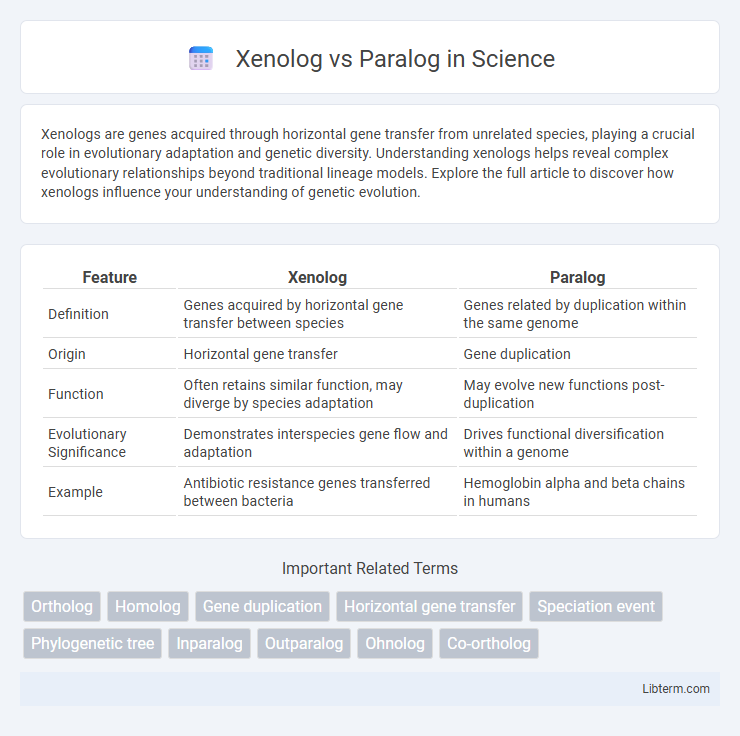Xenologs are genes acquired through horizontal gene transfer from unrelated species, playing a crucial role in evolutionary adaptation and genetic diversity. Understanding xenologs helps reveal complex evolutionary relationships beyond traditional lineage models. Explore the full article to discover how xenologs influence your understanding of genetic evolution.
Table of Comparison
| Feature | Xenolog | Paralog |
|---|---|---|
| Definition | Genes acquired by horizontal gene transfer between species | Genes related by duplication within the same genome |
| Origin | Horizontal gene transfer | Gene duplication |
| Function | Often retains similar function, may diverge by species adaptation | May evolve new functions post-duplication |
| Evolutionary Significance | Demonstrates interspecies gene flow and adaptation | Drives functional diversification within a genome |
| Example | Antibiotic resistance genes transferred between bacteria | Hemoglobin alpha and beta chains in humans |
Understanding Xenologs and Paralogs: Key Definitions
Xenologs are genes acquired through horizontal gene transfer between different species, resulting in similar sequences with different evolutionary origins. Paralogs arise from gene duplication events within the same genome, leading to gene copies that evolve new functions over time. Understanding these definitions clarifies evolutionary relationships and assists in reconstructing phylogenetic histories.
The Origins of Xenologs: Horizontal Gene Transfer
Xenologs originate from horizontal gene transfer (HGT), a process where genes are transferred between different species, unlike paralogs that arise from gene duplication within the same genome. This transfer can occur through mechanisms such as viral infection, conjugation, or transformation, leading to the integration of foreign genes that contribute to genetic diversity and adaptation. Understanding the evolutionary significance of xenologs helps clarify complex phylogenetic relationships by highlighting gene flow across species boundaries.
How Paralogs Arise: Gene Duplication Events
Paralogs arise through gene duplication events where a single ancestral gene is copied within the genome, allowing both copies to evolve independently. This process leads to gene family expansion and diversification of protein functions within the same species. Unlike xenologs, which originate from horizontal gene transfer between species, paralogs result exclusively from internal duplication mechanisms.
Evolutionary Significance of Xenologs
Xenologs arise from horizontal gene transfer between different species, playing a critical role in evolutionary innovation by introducing novel genes that can confer adaptive advantages. Their distinct evolutionary origin compared to paralogs, which result from gene duplication within a species, highlights the importance of xenologs in shaping genomes through lateral gene flow. Xenologs contribute to genetic diversity and can drive rapid evolutionary changes, particularly in microbial communities where horizontal gene transfer is frequent.
Functional Divergence in Paralogs
Paralogs exhibit functional divergence resulting from gene duplication events, leading to specialized roles within the same organism, unlike xenologs which arise from horizontal gene transfer and often retain similar functions in different species. Functional divergence in paralogs is driven by mutations that allow adaptation to new cellular contexts or physiological processes, contributing to evolutionary innovation. This specialization can enhance organismal complexity by enabling distinct but related biological pathways to coexist and operate efficiently.
Comparing Genomic Locations of Xenologs and Paralogs
Xenologs are genes transferred between different species via horizontal gene transfer, often occupying distinct genomic locations compared to their original hosts, while paralogs arise from gene duplication within the same genome, typically located in close proximity or within syntenic regions. Paralogous genes frequently demonstrate conserved genomic neighborhoods due to tandem duplications or segmental duplications, whereas xenologs can integrate into disparate chromosomal regions, reflecting their exogenous origin. Genome mapping reveals that xenologs may disrupt native gene clusters or insert into mobile genetic elements, unlike paralogs which maintain relative positional stability within the host genome.
Implications in Phylogenetic Analysis
Xenologs, originating from horizontal gene transfer events, complicate phylogenetic analysis by introducing genes that do not follow traditional vertical inheritance patterns, often leading to incongruent gene trees. Paralogs result from gene duplication within a species and can mislead phylogenetic inference if gene copies are mistaken for orthologs, causing errors in species tree reconstruction. Accurate distinction between xenologs and paralogs is critical for resolving evolutionary relationships and improving the robustness of phylogenetic trees.
Xenologs vs Paralogs in Functional Genomics
Xenologs and paralogs are types of homologous genes that differ in their evolutionary origins and functional implications in genomics. Xenologs arise from horizontal gene transfer events between species, often conferring novel functions or adaptive traits, while paralogs result from gene duplication within the same genome and typically diversify to gain specialized or redundant functions. Functional genomics studies utilize these distinctions to investigate gene function evolution, with xenologs highlighting cross-species gene acquisition impacts and paralogs providing insights into functional divergence and specialization within genomes.
Challenges in Distinguishing Xenologs from Paralogs
Distinguishing xenologs from paralogs poses significant challenges due to their shared ancestral origins and similar sequence homology, which complicates phylogenetic reconstruction and gene tree reconciliation. Horizontal gene transfer events that define xenologs can obscure lineage-specific duplications characteristic of paralogs, leading to ambiguous evolutionary relationships. Advanced computational methods integrating genomic context and synteny are essential for accurate differentiation between these homologous gene types.
Applications in Biotechnology and Medicine
Xenologs, resulting from horizontal gene transfer, provide unique opportunities in biotechnology for developing novel enzymes and pathways that are not confined by vertical inheritance, enabling innovative drug discovery and synthetic biology applications. Paralogs, derived from gene duplication within the same organism, are critical in medicine for understanding genetic redundancy and functional divergence, aiding in the design of targeted therapies and gene editing strategies. Both xenologs and paralogs enhance the ability to manipulate genetic information, facilitating advances in personalized medicine and metabolic engineering.
Xenolog Infographic

 libterm.com
libterm.com